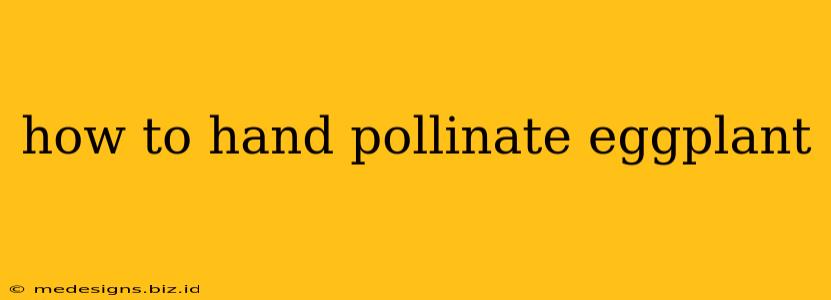Eggplants, with their glossy skin and delicious flesh, are a rewarding addition to any garden. But sometimes, Mother Nature needs a little help. If you're struggling to get your eggplant plants to fruit, hand pollination might be the answer. This guide will walk you through the process, ensuring you get the most out of your eggplant harvest.
Understanding Eggplant Pollination
Eggplants are self-pollinating, meaning the pollen from the flower’s stamen can fertilize its own pistil. However, several factors can hinder this natural process:
- Poor weather conditions: Wind and rain can interfere with pollen transfer.
- Lack of pollinators: While self-pollinating, bees and other insects can still improve pollination efficiency.
- Plant overcrowding: Dense planting limits airflow and insect access.
Hand pollination ensures successful fertilization, even in less-than-ideal conditions.
Tools You'll Need for Hand Pollination
Before you begin, gather these simple materials:
- A small, soft brush: A clean paintbrush or even a cotton swab will work perfectly.
- Tweezers (optional): Useful for gently manipulating the flower parts.
The Step-by-Step Guide to Hand Pollinating Eggplants
Follow these steps for successful hand pollination:
-
Identify the male and female parts: The eggplant flower has both male (stamen) and female (pistil) reproductive parts. The stamen is the pollen-producing part, and the pistil is the part that receives the pollen. The pistil is usually located centrally within the flower.
-
Choose a mature flower: Select a fully opened flower that appears healthy and vibrant. Avoid flowers that are damaged or wilting.
-
Collect the pollen: Gently brush the stamen with your soft brush, collecting the pollen on the bristles.
-
Transfer the pollen: Carefully brush the collected pollen onto the pistil of the same flower or another flower on the same plant (or a different plant if you are trying to cross-pollinate varieties for a unique eggplant). Pay close attention to the stigma, which is the sticky top part of the pistil. This ensures maximum contact.
-
Repeat the process: Repeat steps 3 and 4 on multiple flowers for better chances of successful pollination and fruit set. It’s a good idea to pollinate several flowers per plant.
-
Monitor your plants: After hand pollination, keep an eye on your eggplant plants. You should see fruit developing within a few weeks if pollination was successful.
Tips for Success
- Timing is key: The best time to hand pollinate is during the warmest part of the day, when the flowers are fully open and the pollen is most viable.
- Gently does it: Be careful not to damage the delicate flower parts during the process.
- Multiple flowers: Don't limit yourself to just one flower; pollinate several to increase your chances of success.
- Observe your plants: Note if any flowers are failing to pollinate, as this might indicate another underlying issue.
Troubleshooting
If you're still not seeing fruit after hand pollinating, consider these factors:
- Flower viability: Check to ensure that the flowers you’re using are receptive.
- Nutrient deficiency: Ensure your eggplants receive adequate nutrients. Consult a soil test for guidance.
- Stress factors: Extreme weather conditions, pests, and diseases can affect flowering and fruiting. Address these issues to improve the health of your plants.
By following these steps, you'll significantly improve your eggplant's chances of producing a bountiful harvest. Happy gardening!
